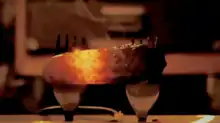Glowing pickle demonstration
Applying line voltage across a pickled cucumber causes it to glow. A moist pickle contains salt as a result of the pickling process, which allows it to conduct electricity. Sodium (or other) ions within the pickle emit light as a result of atomic electron transitions, although it is not clear why the luminescence occurs at one end of the pickle.[1]

The glowing pickle is used to demonstrate ionic conduction and atomic emission in chemistry classes,[2] and also as a demonstration in lighting classes.[3]
The first known fully documented demonstration was in Technical Note 13 entitled "Characterization of Organic Illumination Systems" from Digital Equipment Corporation's Western Research Laboratory, published on April 1st 1989: .[4] Whilst this was published as a full technical note and written up as a scientific paper, the publication day gives some indication as to the light-hearted nature of the document.
References
- Gardner, Martin (19 September 2012). Martin Gardner's Science Magic: Tricks and Puzzles. Courier Corporation. p. 56. ISBN 978-0486152905. Retrieved 6 December 2017.
- Rogers, Casey (June 13, 2011). "Electrocute a Pickle". ChemDemo.
- Hutchison, Jim (August 26, 2013). "How to Make the Electric Pickle Experiment". Jim on Light.
- "Characterization of Organic Illumination Systems" (PDF). April 1, 1989.